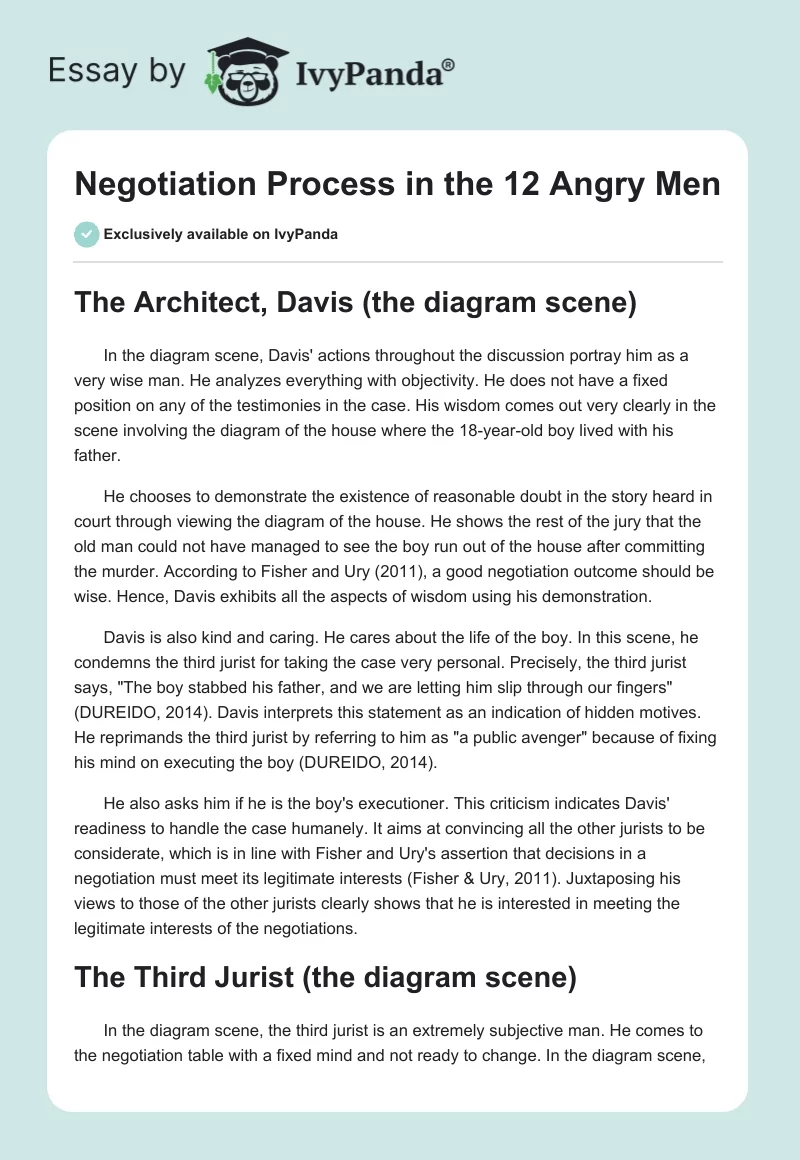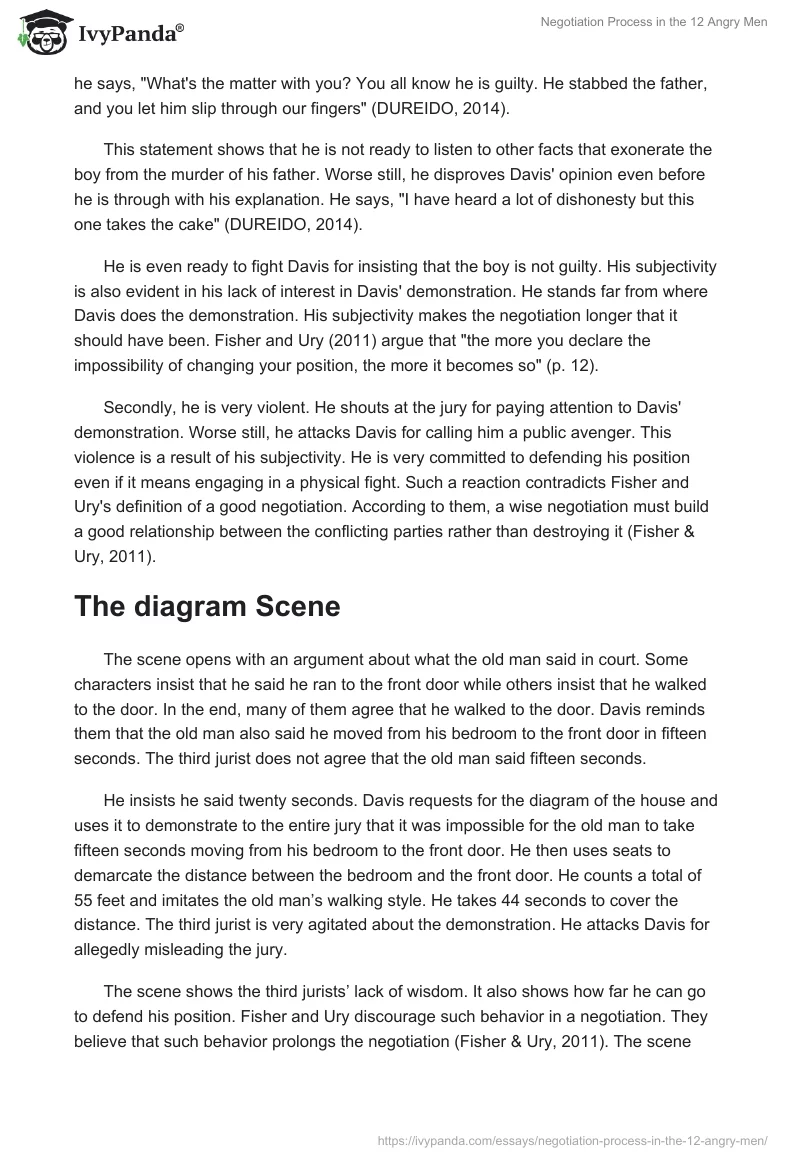The Architect, Davis (the diagram scene)
In the diagram scene, Davis’ actions throughout the discussion portray him as a very wise man. He analyzes everything with objectivity. He does not have a fixed position on any of the testimonies in the case. His wisdom comes out very clearly in the scene involving the diagram of the house where the 18-year-old boy lived with his father.
He chooses to demonstrate the existence of reasonable doubt in the story heard in court through viewing the diagram of the house. He shows the rest of the jury that the old man could not have managed to see the boy run out of the house after committing the murder. According to Fisher and Ury (2011), a good negotiation outcome should be wise. Hence, Davis exhibits all the aspects of wisdom using his demonstration.
Davis is also kind and caring. He cares about the life of the boy. In this scene, he condemns the third jurist for taking the case very personal. Precisely, the third jurist says, “The boy stabbed his father, and we are letting him slip through our fingers” (DUREIDO, 2014). Davis interprets this statement as an indication of hidden motives. He reprimands the third jurist by referring to him as “a public avenger” because of fixing his mind on executing the boy (DUREIDO, 2014).
He also asks him if he is the boy’s executioner. This criticism indicates Davis’ readiness to handle the case humanely. It aims at convincing all the other jurists to be considerate, which is in line with Fisher and Ury’s assertion that decisions in a negotiation must meet its legitimate interests (Fisher & Ury, 2011). Juxtaposing his views to those of the other jurists clearly shows that he is interested in meeting the legitimate interests of the negotiations.
The Third Jurist (the diagram scene)
In the diagram scene, the third jurist is an extremely subjective man. He comes to the negotiation table with a fixed mind and not ready to change. In the diagram scene, he says, “What’s the matter with you? You all know he is guilty. He stabbed the father, and you let him slip through our fingers” (DUREIDO, 2014).
This statement shows that he is not ready to listen to other facts that exonerate the boy from the murder of his father. Worse still, he disproves Davis’ opinion even before he is through with his explanation. He says, “I have heard a lot of dishonesty but this one takes the cake” (DUREIDO, 2014).
He is even ready to fight Davis for insisting that the boy is not guilty. His subjectivity is also evident in his lack of interest in Davis’ demonstration. He stands far from where Davis does the demonstration. His subjectivity makes the negotiation longer that it should have been. Fisher and Ury (2011) argue that “the more you declare the impossibility of changing your position, the more it becomes so” (p. 12).
Secondly, he is very violent. He shouts at the jury for paying attention to Davis’ demonstration. Worse still, he attacks Davis for calling him a public avenger. This violence is a result of his subjectivity. He is very committed to defending his position even if it means engaging in a physical fight. Such a reaction contradicts Fisher and Ury’s definition of a good negotiation. According to them, a wise negotiation must build a good relationship between the conflicting parties rather than destroying it (Fisher & Ury, 2011).
The diagram Scene
The scene opens with an argument about what the old man said in court. Some characters insist that he said he ran to the front door while others insist that he walked to the door. In the end, many of them agree that he walked to the door. Davis reminds them that the old man also said he moved from his bedroom to the front door in fifteen seconds. The third jurist does not agree that the old man said fifteen seconds.
He insists he said twenty seconds. Davis requests for the diagram of the house and uses it to demonstrate to the entire jury that it was impossible for the old man to take fifteen seconds moving from his bedroom to the front door. He then uses seats to demarcate the distance between the bedroom and the front door. He counts a total of 55 feet and imitates the old man’s walking style. He takes 44 seconds to cover the distance. The third jurist is very agitated about the demonstration. He attacks Davis for allegedly misleading the jury.
The scene shows the third jurists’ lack of wisdom. It also shows how far he can go to defend his position. Fisher and Ury discourage such behavior in a negotiation. They believe that such behavior prolongs the negotiation (Fisher & Ury, 2011). The scene also confirms their assertion that the presence of many parties brings about many varied opinions that the parties have to defend (Fisher & Ury, 2011).
Conclusion
The diagram scene portrays Davies and the third jurist as having two different standpoints about whether the boy killed his father or not. Davis goes to the negotiation table with an objective mind while the third jurist goes there with a position to defend.
Davis argues that they should not be very sure about what happened before analyzing all the facts while the third jurists believes it is obvious that the boy is guilty. Eventually, the entire jury agrees that there is reasonable doubt in the facts presented in court. Davis’s style of negotiation agrees with Fisher and Ury’s conception of the proper way to conduct negotiations: parties should not have positions to defend.
References
Fisher, R. & Ury, W. (2011). Getting to yes. New York: Penguin Publishers.
DUREIDO, F. (2014, Apr. 8). 12 Angry men 1957. [Video file].


